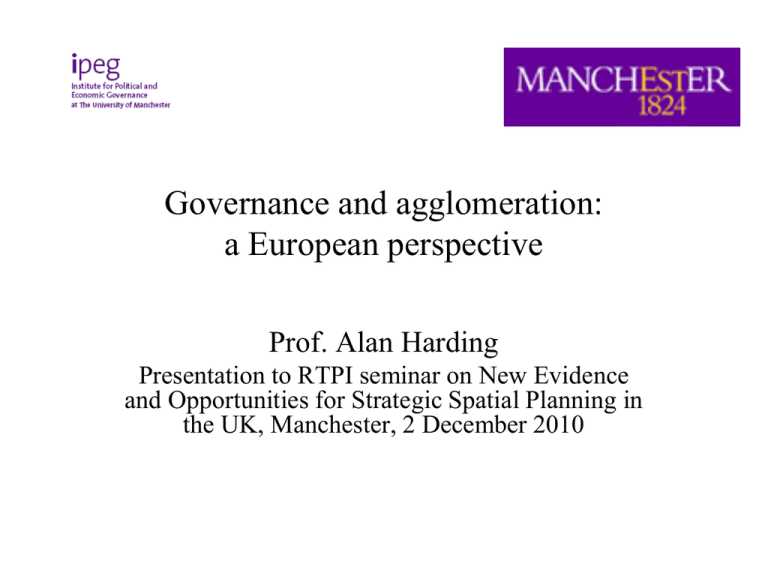
Governance and agglomeration:
a European perspective
Prof. Alan Harding
Presentation to RTPI seminar on New Evidence
and Opportunities for Strategic Spatial Planning in
the UK, Manchester, 2 December 2010
On the one hand....
• City-regions are locomotives of the national economies
within which they are situated, in that they are the sites of
dense masses of interrelated economic activities that also
typically have high levels of productivity by reason of their
jointly-generated agglomeration economies and their
innovative potentials
Scott and Storper, 2003
• Metropolitan spaces are becoming, more and more, the
adequate ecosystems of advanced technology and
economy…. [T]he decrease of communication costs does
not by itself lead to a spreading and diffusion of wealth
and power; on the contrary, it entails their polarization.
Veltz, 2005
The ‘new’ agglomeration
• Literally, means ‘gathering together in a mass’
• Old urban (economic) geography concept with 2
competing traditions
•
•
•
‘Localisation economies’, benefits experienced by firms from co-location
(More recent versions; New Industrial Districts, Porter on ‘clusters’)
‘Urbanisation economies’, benefits derived by workers and households as well
as firms from city size, density and variety (More recent versions; Florida on
‘the creative class’, Storper/Venables on urban ‘buzz’)
Associated with key observations e.g. productivity benefits of population
growth, urban wage premium (within cities and on departure)
• Recent rediscovery by economists who had previously
ignored ‘increasing returns to scale’
•
Has become basis of new work on, e.g. ‘spillover effects’, ‘effective density’,
attempts to explain why falling transport costs should be associated with
concentration rather than dispersal of economic activity
Towards an ‘archipelago economy’
• The knowledge economy and the ‘new’
agglomeration is argued, across soc. sci.s, to have
shifted the spatial division of labour, due to:
• Falling trade and communication costs
• Changing organisational structure of firms (flattened
hierarchies, outsourcing, linkages, proximity)
• Risk, knowledge-intensive production, density of suppliers
and continued importance of face-to-face communications
• Changes in labour markets & household formation
patterns; insurance against under- & unemployment, ‘buzz’
in areas with rich, dense labour markets
• Housing, capital accumulation and barriers to exit from
key metropolitan regions
.. and its implications?
• Big, dense, diverse, well-connected cityregions increasingly drive regional, and by
implication national, economic performance
• But the world is getting spikier:
performance gap between city-regions is
growing; stretching urban hierarchies
• What’s the evidence?
THE WORLD WAS ALWAYS SPIKY
@
THE 90s/’NOUGHTIES’ BOOM
MADE IT SPIKIER
Gross Value Added 2006 (at basic prices)
Figures in millions of Euros
50,000 to 175,000
20,000 to 50,000
13,000 to 20,000
8,000 to 13,000
4,900 to 10,500
0 to
4,900
(5)
(23)
(23)
(20)
(17)
(19)
©
©
© Crown
Crown
Crown Copy
Copy
Copyright.
right.
right. All
All
All rights
rights
rights reserv
reserv
reserved
ed
ed
Licence
Licence number:
number:
number: 100019918.
100019918.
100019918. 2009.
2009.
2009.
Licence
number:
100019918.
2009.
Licence
Licence
number:
100019918.
2009.
Groningen
Groningen
Birmingham
Birmingham
Amsterdam
Bristol
Bristol
Cardiff
Cardiff
London
Dusseldorf
Dusseldorf
Koln
Koln
Brussels
Lille
Lille
Luxembourg
Paris
Paris
Nantes
Nantes
Bern
Torino
Torino
Toulouse
Toulouse
Lyon
Lyon
Montpellier
Montpellier
Aix-Marseille
Aix-Marseille
Manchester
Manchester
Change in GVA, 1996 - 2006
Figures in millions of Euros
8,000
6,000
3,000
2,000
1,000
600
300
0
to
to
to
to
to
to
to
to
30,000
8,000
6,000
3,000
2,000
1,000
600
300
(5)
(7)
Birmingham
Birmingham
(12)
(20)
(21)
(17)
(9)
(5)
Bristol
Bristol
Bristol
Cardiff
Cardiff Bristol
Amsterdam
Amsterdam
London
London
Brussels
Brussels
Lille
Lille
Luxembourg
Luxembourg
Paris
Paris
Nantes
Nantes
Bern
Bern
Toulouse
Toulouse
Lyon
Lyon
Montpellier
Montpellier
Aix-Marseille
Aix-Marseille
0
50
miles
100
Gross Value Added, 2006 (2000 prices)
Figures in millions of Euros
30,000
13,000
11,600
11,000
10,000
5,000
to
to
to
to
to
to
56,000
30,000
13,000
11,600
11,000
10,000
(1)
(1)
(1)
(1)
(2)
(2)
Belfast
Belfast
Dublin
Dublin
Galway
Galway
Cork
Cork
GVA Change, 1996 - 2006
Figures in millions of Euros
20,000
8,000
7,000
5,600
5,500
5,300
3,000
2,000
to
to
to
to
to
to
to
to
30,000
20,000
8,000
7,000
5,600
5,500
5,300
3,000
(1)
(1)
(1)
(1)
(1)
(1)
(1)
(1)
Belfast
Belfast
Dublin
Dublin
Galway
Galway
Cork
Cork
Gross Value Added 2006
Montpellie
Figures in millions of Euros
36,000 to 175,000 (3)
21,000 to 36,000 (9)
12,500 to 21,000 (9)
9,300 to 12,500 (9)
4,700 to 9,300 (10)
0 to 4,700 (10)
Toulouse
Zaragoza
Zaragoza
© Crow n Copyright. All rights reserved
Licence number: 100019918. 2009.
Barcelona
Valencia
Lisbon
0
Madrid
100
miles
200
Aix-Marseille
Aix-Marseille
Toulouse
Toulouse
Montpellier
Montpellier
0
50
miles
Barcelona
Barcelona
Madrid
Madrid
Zaragoza
Zaragoza
Valencia
Valencia
Lisbon
Lisbon
GVA Change, 1996 - 2006
Figures in millions of Euros
(c) Crown Copyright. All rights reserved.
Licence number 100019918 (2010)
8,000 to 50,000
4,000 to 8,000
3,000 to 4,000
2,000 to 3,000
1,500 to 2,000
1,000 to 1,500
450 to 1,000
100 to 450
(4)
(9)
(7)
(6)
(4)
(7)
(8)
(5)
100
© Crown Copyright. All rights res erved.
License num ber 100019918. 2009.
Gros s Value Added 2006
(Figures in millions of Euros )
36,000 to 175,000
18,000 to 36,000
10,500 to 18,000
7,000 to 10,500
4,900 to
7,000
0 to
4,900
(10)
(23)
(24)
(24)
(28)
(24)
Edinburgh
Edinburgh
Edinburgh
Glasgow
Glasgow
Glasgow
Newcastle
Newcastle
Newcastle
Leeds-Bradford
Leeds-Bradford
Leeds-Bradford
Belfast
Belfast
Belfast
Manchester
Manchester
Manchester
Dublin
Galway
Galway
Galway
Birmingham
Birmingham
Birmingham
Bristol
Bristol
Bristol
Cork
Cork
Cork
London
Cardiff
Cardiff
Cardiff
0
50
miles
100
Lille
Lille
Lille
GVA Change, 1996 - 2006
Figures in millions of Euros
14,000
7,000
4,000
2,500
1,500
600
0
-700
to 50,000
(4)
to 14,000
(7)
to 7,000 (19)
to 4,000 (16)
to 2,500 (23)
to 1,500 (28)
to
600 (29)
to
0
(7)
Edinburgh
Edinburgh
Edinburgh
Glas
Glas
Glasgow
gow
gow
Newcas
Newcas
Newcastle
tle
tle
Belfas
Belfas
Belfasttt
Leeds
Leeds
Leeds-Bradford
-Bradford
-Bradford
Manches
Manches
Manchester
ter
ter
Dublin
Dublin
Dublin
Galway
Galway
Galway
Birm
Birm
Birmingham
ingham
ingham
Cork
Cork
Cork
London
London
London
0
50
miles
100
Cardiff
Cardiff
Cardiff
Bris
Bris
Bristol
tol
tol
Lille
Lille
Lille
(c) Crown Copyright. All rights res erved.
Total productivity: Agglomeration estimates
Nuts 2
Nuts 3
Nuts 3 Large
Cities
Full
13.57%**
Sample
12.54%***
4.19%
1980s
8.34%**
5.05%
3.52%
1990s
-1.99%
-6.77%
-1.82%
2000s
10.26%*** 6.80%*
10.46%***
SPIKINESS IS INTRA- AS WELL AS
INTER-CITY REGIONAL
0
Bury
10 Bolton
5
town centre
miles
Wigan
town centre
Rochdale
Middlebrook
Oldham
Ashton
-underLy ne
Dukinf ield
Traf f ord Centre
Manchester
City Centre
Stockport
Total employment in 2008
- all sectors
1,000 to 75,248
500 to
999
200 to
499
100 to
199
1 to
99
(229)
(186)
(483)
(381)
(367)
Altrincham
Wy thenshawe
Hospital
Manchester
Airport
© Crown Copy right.
All rights reserv ed.
Licence No 100019918 2010
Hey wood
0
5
10
miles
Rochdale
Swinton
Middlebrook
Manchester
City Centre
Change in employment 2003-2008 in
- all sectors
1,000 to 11,827
500 to 1,000
250 to
500
0 to
250
-250 to
0
-500 to -250
-1,000 to -500
-5,941 to -1,000
(33)
(39)
(67)
(644)
(684)
(98)
(52)
(29)
Cheadle
Traf f ord
Centre
© Crown Copy right.
All rights reserv ed.
Licence No 100019918 2010
Manchester
Airport
Woodf ord
AND THE BUST IS MAKING IT
SPIKIER STILL
Recession, recovery, spikiness
• Areas and communities suffering
worst are those that benefited least
from the boom years, i.e.
• Places lacking a ‘knowledge
economy’ and/or ‘knowledge
workers’
• The disconnected spaces in
erstwhile booming places
BUT WHAT ABOUT GOVERNANCE?
Metropolitan/city-regional productivity
and governance
•
•
•
•
•
Much generalised (critical) analysis of state restructuring and ‘neoliberalism’ but limited literature on meso-level governance and
economic change
Work of Cheshire and Magrini (2008) demonstrates statistical
association between economic performance and existence of
metropolitan/city-regional tier /unit of governance
But treats governance as a ‘black box’
Little appreciation of what metropolitan/city-regional
governance arrangements actually do and how they relate to
other scales of governance/market-based decision-making
Hence the CAEE project: fusing of (a) advanced econometric
assessment of importance of agglomeration and (b) political
science approach to the characteristics of metropolitan/cityregional governance
Metro-complexity
•
•
•
Huge variation in degrees of institutionalisation of metro
areas/city-regions and in their autonomy, executive capacity,
political influence
Key challenge: ‘going with the grain’ of the ‘new’ agglomeration
rather than resisting it. Fusing ‘competitiveness’ policies (often
non-spatial) with (usually spatial) ‘cohesion’ policies
‘Forms of [metropolitan and city-regional] governance.. can be
interpreted as partial, and inevitably incomplete, attempts to
assemble the capacity, autonomy and forms of influence that make
it possible to deal more effectively with the challenges that new
patterns of economic change throw up.’ [CAEE final report]
‘Best practice’
•
On basis of case studies, ‘ideal type’ metro/city-regional
arrangements have..
• Supportive national context
• Strong technical capacity (analytical and delivery) at
appropriate scale
• Significant influence at regional/national scales
• Strong horizonal networks with key public and private
institutions
• A compelling and broadly-shared ‘narrative’
• Strong leadership and co-ordinating capacity
• Ability to recognise and deal with the environmental and social
implications of realising its strategic ambitions
SO WHAT FOR UK SPATIAL POLICY?
The coalition government’s
spatial agenda
• Aspects of ‘rebalancing’ potentially supportive of ‘2nd
division’ metro areas/city-regions
• No more (formal) sub-national spatial planning; national
development framework promised but timing uncertain
• But effect of public sector cuts likely to work against
spatial rebalancing and LEPs likely to favour localities
with market advantages
• Rate capping plus incentives to LAs for new commercial
and residential development will strain LEP relations
• LG resource review potentially deepens inter-LA
competition









